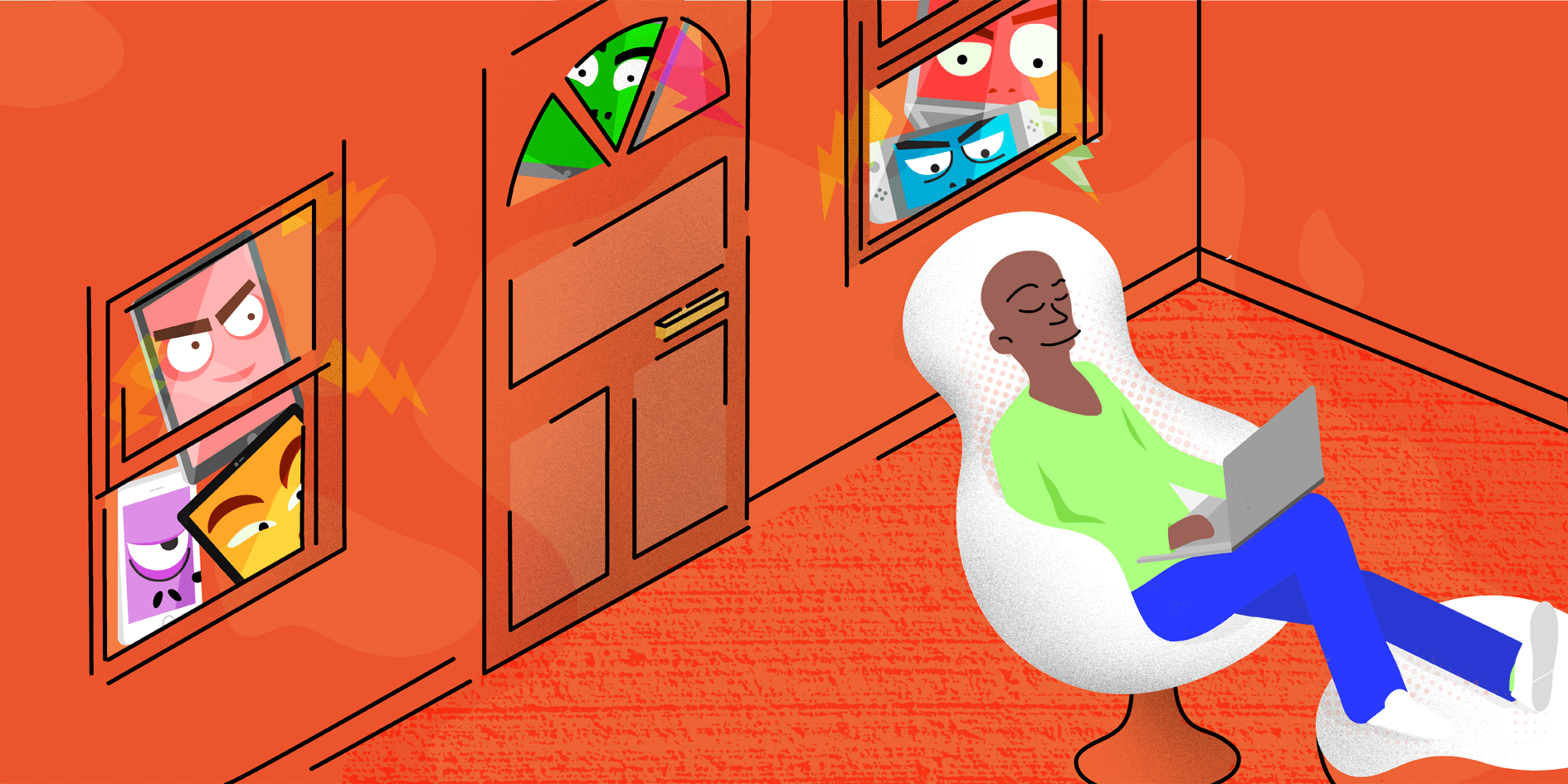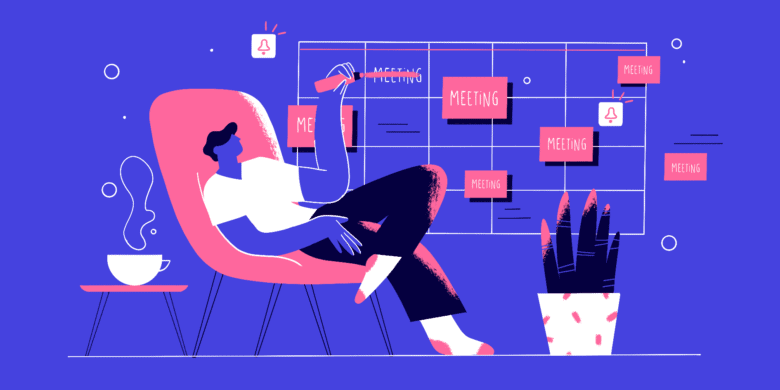Great news for remote workers: technology is stressing us out. A 2017 study conducted by University of Gothenburg, Sweden proposed that cell phone, computer, and television use are directly linked to stress levels, quality of sleep, and even overall mental health. This is referred to as technostress, and if your shoulders tensed up at the word, you’re not alone.
Technostress, defined as a new age disease caused by use of modern technologies, can happen when technology overwhelms instead of helps us, or when we have to quickly adapt to change over and over. It’s fairly common, especially since most workplaces rely on computers and other devices to complete daily tasks.
But there’s more to it. As a consequence of using more and newer computing technologies, and for remote workers especially, there is an additional concern: online privacy. With 46% of remote employees transferring files between work and personal devices, there are plenty of opportunities for files to get into the wrong hands or lost along the way.
It can be a challenge to overcome technology stress for sure, but there are ways to deal with this in a healthier manner.
The key to relieving technostress? Making sure the technology you’re using is useful and reliable.
In this post, we’ll explore all the ways remote and tech-savvy teams can assess and improve their tech practices. Being mindful of security standard maintenance and other tech-related behaviors can ultimately reduce stress in and out of the work environment. Deep breath in. Deep breath out. Let’s get started.
Boost your team’s efficiency with Hubstaff's productivity tools
Turning technostress to tech success at work
1. Manage your time like a pro
There are plenty of time management systems out there that make the most of your screen time, but they all revolve around one idea: setting aside time for focused, deep work. Jumping from project-to-project, checking emails every five minutes, and never turning off your device are going to add to your tech stress by depleting your energy faster.
Instead, spend time on specific tasks that line up with the organization’s priorities. Aim to achieve short-term goals in a timely fashion, one tab at a time, to avoid the procrastination tension we’ve all faced at some point.
Planning your week ahead of time is a great way to ensure you won’t succumb to technostress. Try devoting a little time every Friday to plan for the following week. That way, you won’t feel overwhelmed when you log in bright and early Monday morning.
2. Streamline communication
In order to enforce any policies or protocols, communication must be established and encouraged on all levels. This doesn’t necessarily mean communicating more frequently, but instead finding ways to communicate more efficiently within your company.
Investing in project and time management software can help bridge any gaps in communication between employees and employers, both on-site and remote. Again, making sure your communication platforms are as useful and reliable as possible can reduce unnecessary stress.
For internal communications, we use Slack for its team-friendly tools and integrations. Bring as many or as few people into a message and hammer out ideas, or use it to post team updates. Useful? Check. Reliable? You bet.
In addition to Slack, most teams use a project management tool such as Basecamp or Trello.
Once you’ve locked in your PM and communication tools, you can start streamlining other mundane tasks that take up too much time, like scheduling meetings. Calendly, a simple way to book meetings, connects your calendars so all you have to do is send out a link to participants. Once the meeting is confirmed, the event shows up for everyone, and even sends a reminder.

There’s a whole world of automation out there that can immediately take tech-related work off your plate. Zapier, for example, integrates all the various business apps you use so you can create a workflow for pretty much any process. If data entry takes up any amount of your day, there’s a Zapier integration for you.
If you don’t use technology to make even a small part of your work better, or if your current software isn’t working for you, research alternatives that can help you better accomplish goals. There’s no reason to stick with a system that doesn’t help you or improve your business.
Subscribe to the Hubstaff blog for more posts like this
3. Create a security protocol
If you use a personal device for work, or are operating on a non-secure network, you may leave yourself vulnerable to having information and files lost, or even run the risk of identity theft.
If you don’t have one already, consider organizing a security standard for office and remote workplaces to lower the risk of confidential company and employee information exposure. Enabling automatic software updates across work and personal devices ensures any bugs or weaknesses in previous updates are fixed, and also helps the device to operate efficiently.
Further, you should also enforce 2-Factor Authentication (2FA) across your organization, as an extra layer of security without too much inconvenience.
But wait, there are more (security measures to take). You can require passwords to be updated every quarter, and offer a security training to your team. Those are just two of the seven ways that companies can protect themselves against a data breach we wrote about previously. Check out the entire post for more helpful tips.
Creating a plan as an employer, and abiding by company security policies as an on-site or remote worker, is the most proactive way to prevent data breaches and information loss on both employee and corporate levels.
Checking the SSL/ TLS Certificate validation is also something you might consider helpful. Broken links, blank pages, DNS blacklisting, and email box validation should be on your agenda. And you can test all of the above via the free test tools from WebSitePulse.

4. Implement a privacy plan
Along with security protocols, establishing a company-wide privacy plan for workplace computers is crucial to protecting company and employee data. Using separate devices for work and personal use not only encourages confidentiality regarding work files, but it also allows employees to unplug at the end of their work day.
This can be difficult for a remote workforce, as team members often use their own devices for work functions. In this case, it’s important to communicate expectations for how the device is used when it comes to work. One example would be to require passwords or biometric security to access the device.
As an employer, it is important to be explicit and transparent when communicating privacy expectations. You can reduce the tech stress of handling secure files by taking added precautions and following best practices.
5. Simplify remote team management
When it comes to managing remote teams, technology can be a gift and a burden. On one hand, technology allows distributed teams to work together no matter where they’re located. On the other hand, the freedom that technology allows means that it can be tough to know who is working on what.
Enter time and productivity management apps. Now, there’s software that allows teams to track their time on projects and tasks without having to manually fill out a timesheet. Most tools run in the background, either on desktop or mobile, so you can simply start the clock and start working.
With options like capturing screenshots and URLs while the clock is running, teams can record what they’re working on without having to report back as often. Managers and employees don’t have to be constantly updating each other on progress — which can be an unintended and unfortunate side effect of working as a remote team.
Time tracking tools like Hubstaff allow you to know what your team is working on without having to circle back, close the loop, touch base… you get the idea.

6. Please turn off your personal devices
Even if you use technology for work (everyone), having a personal device nearby can add unnecessary stress and distraction to your day.

An episode of WorkLife with Adam Grant discussed recent studies that show if you use an electronic device during a class or meeting, you learn and contribute less. Just having your smartphone on your desk reduces working memory by 10%, even in airplane mode. Yeah. In airplane mode. As Adam Grant explains, “Just seeing your phone is enough to send your mind wandering.”
Such distractions during the workday are reason enough for some companies to create a policy around personal devices. Film director Christopher Nolan bans cell phones on movie sets. Other people choose to set auto-responses that limit the time of day they’ll respond to email. Not saying that either of those are right for you, but it might help to think about the distractions your device may offer, and come up with a way to limit those.
How to limit technology stress outside of work hours
As a manager, it’s important to model positive tech behaviors for your team so that everyone knows it’s okay to unplug. Hopefully this post will inspire a healthy discussion about tech, work, and downtime with your team. If you do, let us know what other ideas come up so we can add it to our list.
As Virgin Group founder Richard Branson famously said, “If you look after your staff, they’ll look after your customers. It’s that simple.”
7. Unplug every once in awhile
This one is important for business owners and employees, as we all face the effects of screen time overload.
Quick poll: What’s the first thing you do when you wake up? Is it roll over and turn on your phone? *Raises hand slowly*
Tristan Harris, Google’s former Design Ethicist, explains why this is a big mistake. “When we wake up and see a list of notifications, it frames the experience of ‘waking up in the morning’ around a menu of ‘all the things I’ve missed since yesterday,’” he said.
Instead of hopping on Twitter right after you open your eyes, he recommends another activity that’s, “More aligned with your true needs.” Making coffee, going outside, talking with family, or meditating are all good substitutes.
Another bummer for screen-heavy workers? Eye strain. Staring at a computer screen for countless hours a week can cause eye strain and a number of other health concerns. To combat this type of eye fatigue, try these steps from the Vision Council:
- The 20-20-20 rule: Take a 20-second break from the screen every 20 minutes by looking at something that’s 20 feet away
- Remove or reduce overhead lighting to eliminate screen glare
- Stay an arm’s distance away from the screen for proper viewing distance
- Increase the text size on devices
8. Make time to wind down
You can keep the positive tech behaviors going by limiting the time spent on a device before you go to sleep. This Harvard Health article suggests avoiding screens two to three hours before bed, as blue light can have the biggest impact on circadian rhythms — which can disrupt your sleep cycle.
To help wind down on screen time at the end of the day, you can also set rules for yourself like no phones during dinner, or no email between the hours of 11 p.m. and 6 a.m. Make time for visiting with family and friends, enjoying nature, or finding local activities instead.
Before you power down your device for the day, consider using a meditation app to get you in the right mindset. Calm can help you meditate, breathe, and relax, all from a mobile device. Plus, they have a sleep mist you can use before bed, which is 100% blue light-free.
Long story short, reducing screen time is a recommended practice.
There’s even a Screen-Free Week that encourages both children and adults to disconnect from tech every so often and get active. Limiting tech time is a great way to reduce stress, social anxiety, and, by extension, temporarily reduce your risk of accidentally downloading a virus or spyware-containing file. Participating in Screen-Free Week and applying these ideas on a regular basis is highly recommended, especially on nights and weekends. Conveniently, there are plenty of screen-free activities to keep you busy and your mind clear off-the-clock.
In summary, here are our quick technostress reduction tips:
- Manage your own time better with productivity techniques
- Streamline communications and operations by using the best and most secure software for your team
- Create security policies for network, personal, and client information
- Protect your privacy by changing passwords often and scheduling software updates
- Implement time tracking and productivity monitoring software
- Power down personal devices for deep focus
- Unplug every now and then
- Limit screen time outside of work, especially two to three hours before bed
Once you get through the list, be sure to perform regular reviews, approximately every six months, in order to track progress and identify areas for improvement.
What are your thoughts?
How do you fend off technostress? Do you unplug every once in awhile? Enforce deep focus time? What does your team do to protect security and privacy? Let us know in the comments.
Most popular
The Critical Role of Employee Monitoring and Workplace Security
Why do we need employee monitoring and workplace security? Companies had to adapt fast when the world shifted to remote work...
15 Ways to Use AI in the Workforce
Whether through AI-powered project management, strategic planning, or simply automating simple admin work, we’ve seen a dramatic...
The AI Productivity Panel: Lessons From Leaders on What’s Working (and What’s Not)
When I moderated this AI productivity panel, I expected a solid conversation. What I didn’t expect was the flood of real-world i...
Employee Performance Dashboards: Templates, Tools, and Best Practices
Keeping track of how your team’s really doing can be tricky. Spreadsheets pile up, one-on-ones only tell part of the story, and...




